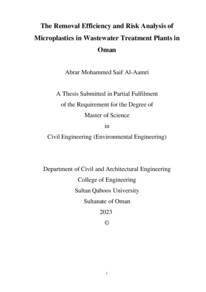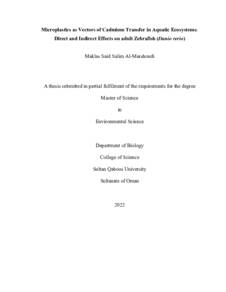Document
The Removal efficiency and risk analysis of microplastics in wastewater treatment plants in Oman.
Other titles
كفاءة إزالة وتحليل مخاطر اللدائن البلاستيكية الدقيقة في محطات معالجة مياه الصرف في عمان
Publisher
Sultan Qaboos University.
Gregorian
2023
Language
English
English abstract
Microplastics (MPs) have recently been documented as an emerging pollutant that poses a
critical threat to human beings, and aquatic as well as terrestrial ecosystems. Wastewater
treatment plants (WWTPs) are usually suspected of being major contributors to
environmental microplastics that can rise environmental disutility in distinct ways. This
study aimed to determine the removal rates and microplastic concentration of three
wastewater treatment plants in Oman with different treatment processes which are
conventional activated sludge (CAS), membrane bioreactor (MBR), and sequence batch
reactor (SBR). Wastewater samples from different treatment stages were collected and
analyzed to determine the morphology, size, color, and polymer type. The collected
samples were filtered through a set of sieves ranging from 1 mm to 45 µm. Oxidation
treatment was applied for all samples using Fenton's reagent followed by density
separation by sodium chloride solution. 10% from each sampling point was tested utilizing
Attenuated Total Reflectance Fourier Transform Infrared Spectroscopy (ATR- FTIR) to
confirm the polymer types of MPs. Risk assessment was performed using both the
pollution load index (PLI) and hazard index (HI) based on the chemical toxicity and
concentration of the detected particles in all examined WWTPs. The PROMETHEE
method was used to rank the risk of sampling sites based on different criteria that posed
potential ecological and human health risks.
Overall, the results show that the average number of 0.99 MP/L, 1.38 MP/L, and 0.93
MP/L was found in the final treated effluent of Samail WWTP, Al Seeb WWTP, and Al
Ansab WWTP, with overall removal efficiencies of 82.5%, 77.4%, and 79.2%,
respectively. The number of MPs in sludge samples was 77.1 MP/L, 49.7 MP/L, and 80.3
MP/L found in Samail WWTP, Al Seeb WWTP, and Al Ansab WWTP, respectively. The
combined load of microplastics released from all three WWTPs with discharged treated
effluent totaled 187.2 ×106 per day. Most detected MPs in tertiary effluent were small (<
425 µm) and fibers in shape. Although diverse treatment stages are capable of removing a
significant proportion of MPs, microfibers can effectively survive the studied treatment
processes, including advanced treatment using ultrafiltration (UF). The major types of MPs
in this study were polypropylene, low-density polyethylene, polyurethane, polyethylene
terephthalate, and Polyvinyl chloride. Al Ansab sludge was ranked as the most hazardous
sampling site. The outcomes of this study show that a considerable number of microplastics
are discharged into the environment through treated effluent and sludge. The application
of on-site management advanced practices for microplastic remediation such as
nanotechnology shall be recommended to the wastewater management authority in Oman.
Member of
Resource URL
Category
Theses and Dissertations


